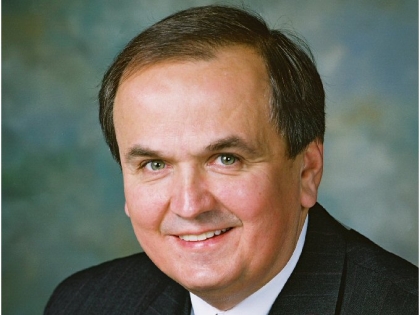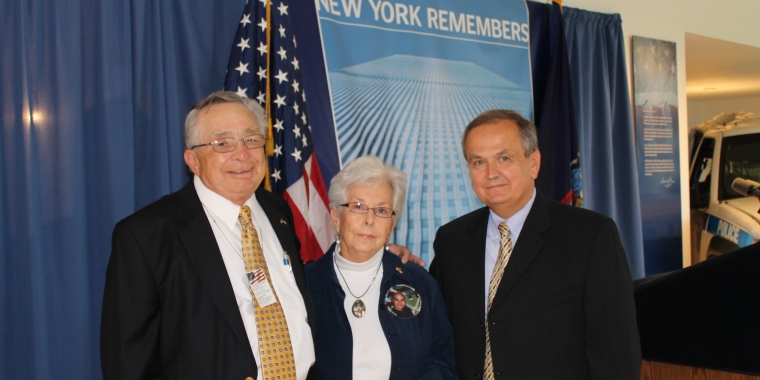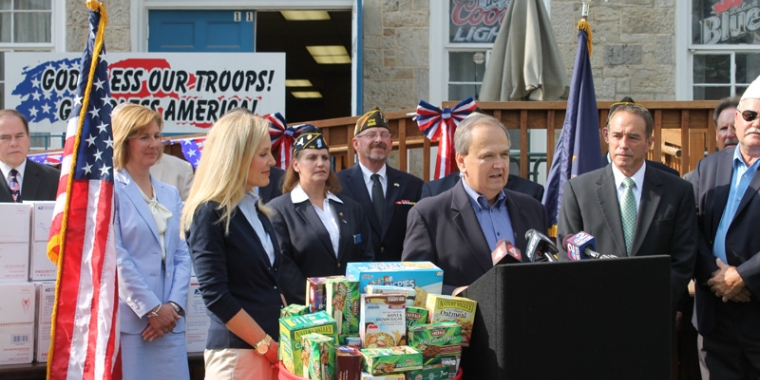
"New York Remembers" exhibit highlights 9/11 anniversary
George D. Maziarz
September 8, 2011

Senator George Maziarz joined Governor Andrew Cuomo, family members of victims, and first responders at the Burchfield Penney Art Center at Buffalo State College to commemorate the tenth anniversary of September 11th via the New York Remembers exhibition. In the accompanying photo, Senator Maziarz poses with Mr. & Mrs. Len Castriano, Sr, who lost their son in the World Trade Center attacks.
Senator George Maziarz said, "The ten year anniversary of September 11 is a milestone that we remember with sadness and awe. The unprecedented attacks on our country changed us as individuals and as a nation. We all experienced this profound tragedy, we united in its aftermath, and now we are remembering together. The New York Remembers initiative, spearheaded by the Governor, will help all New Yorkers reflect on the past, and consider how we can move forward as a people."
"This exhibit gives New Yorkers here in Buffalo and in Western New York an opportunity to gather to remember those who died on September 11th and embrace the spirit of unity that brought us together ten years ago," Governor Cuomo said. "We will never forget those who lost their lives and the countless acts of heroism by our first responders. As we commemorate the ten year anniversary, these exhibits will allow us to reflect and mourn, while also educating a new generation about September 11th."
On August 10, Governor Cuomo, the New York State Museum, and the National September 11 Memorial and Museum announced the "New York Remembers" exhibitions in 30 locations across the state. The exhibitions will give New Yorkers a place to remember the victims of September 11th and honor the countless heroes who came from all corners of the state to help in the clean-up and recovery efforts. The exhibitions will feature historical artifacts from the collections of the State Museum and the National September 11 Memorial & Museum.
Leonard Castriano, father of Lenny Castriano Jr., who worked on the 105th floor of World Trade Center 1, said, "The 9/11 terrorist attacks affected communities all across the state, and Buffalo was not spared. On the 10th anniversary of September 11, it is crucial for New Yorkers to be able to gather together and honor those who perished at the World Trade Center, like my son Lenny, the Pentagon and on the planes. I thank Governor Cuomo for his efforts in creating special exhibits so our towns and cities can reflect on what blinding hatred can do, and remember that fateful day."
Aaron Podolefsky, President of Buffalo State, said, "The artifacts on display as part of the 'New York Remembers' exhibit are vital pieces of American history and tributes to those who served and sacrificed. The Buffalo State community is honored to host this exhibit and to welcome Governor Cuomo once again to our campus. We hope our neighbors throughout Western New York will visit the exhibit to mark the tenth anniversary of the September 11 attacks."
Each location will remain open until the end of September. All will be open on Sunday, September 11th.
Many of the artifacts being exhibited have never been seen by the public, including: the trailer used by families visiting Ground Zero that includes photographs and messages; damaged emergency vehicles and other vehicle parts; aluminum and glass from the buildings; religious "symbol steel" created by the workers at the site; and airplane fragments including landing gear and engine parts. The stories behind all the artifacts will be told as part of the exhibitions.
With more than 2,000 artifacts, the New York State Museum is the nation's largest repository of objects recovered from the World Trade Center site after September 11, 2001. Within weeks of the attacks, State Museum staff documented the operations at the WTC site and later spent countless hours at the WTC Recovery Operation at Fresh Kills where all the material was inspected. In the ten months that followed the attacks, the FBI and NYPD recovered over 50,000 pieces of personal property. The Museum also documented the Fresh Kills operation with hundreds of photographs, interviews, and films.
The FBI and NYPD transferred all artifacts to the Museum after they were designated non-essential to the crime scene as neither criminal evidence nor personal property. Items include rescue artifacts, building pieces, everyday artifacts, and other objects from the site. No object collected from Fresh Kills by the State Museum was kept if it could be identified as owned by an individual. Vehicles like a FDNY truck were signed over to the State Museum by the FDNY via a deed of gift by the specific agency. Forty-nine pieces of the two airplanes that crashed into the towers were transferred to the State Museum by the FBI. These include fuselage, interior, and engine parts.
The State Museum also has a significant collection of sympathy material from the New York City area, New York State, and across the world.
ABOUT THE NATIONAL SEPTEMBER 11 MEMORIAL & MUSEUM
The National September 11 Memorial & Museum is the not-for-profit corporation created to oversee the design, fundraising, programming, and operations of the Memorial & Museum at the World Trade Center. The Memorial & Museum will be located on eight of the sixteen acres of the World Trade Center site. The Memorial will be dedicated on the tenth anniversary of the 9/11 attacks and will open to the public the following day, and the Museum will open in September 2012.
The Memorial will remember and honor the thousands of people who were killed in the horrific attacks of September 11, 2001 and February 26, 1993. The design, created by Michael Arad and Peter Walker, consists of two reflecting pools formed in the footprints of the original Twin Towers and a plaza of trees.
The Museum will display monumental artifacts linked to the events of 9/11, while presenting intimate stories of loss, compassion, reckoning, and recovery that are central to telling the story of the 2001 and 1993 attacks and the aftermath. It will communicate key messages that embrace both the specificity and the universal implications of the events of 9/11; document the impact of those events on individual lives, as well as on local, national, and international communities; and explore the continuing significance of these events for our global community.
